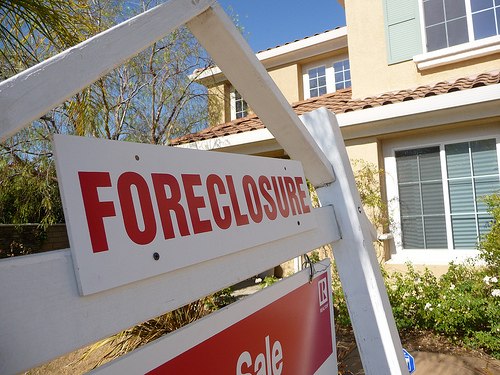Lenders, Servicers Fight Anti-Blight and Property Laws
As bank-owned foreclosed properties pile up across the country, from abandoned houses in hard-hit neighborhoods to empty big box retail stores in failed strip malls, the fight over holding someone responsible for the brick and mortar mess left behind by the mortgage crisis continues to heat up.
Jul 31, 2020471 Shares470.8K Views
Flickr: respres
As bank-ownedforeclosed properties pile up across the country, from abandoned houses in hard-hit neighborhoods to emptybig box retail stores in failed strip malls, the fight over holding someone responsible for the brick and mortar mess left behind by the mortgage crisis continues to heat up.
More than two years into the crisis, local authorities still are slapping banks, servicers and speculators with fines ranging from $30,000 to even $90,000 for ignoring orders to take care of foreclosed and vacant properties under their control. The continuing punitive measures come as servicers already find themselves under fire for failing to complete more loan modifications under the Obama administration’s Making Home Affordable program – an effort that includes $75 billion in taxpayer money as incentives for the lending industry to rework loans. And it also comes as some realtors and lenders are mounting challenges to local anti-blight ordinances, and promoting the use of a mortgage database to track down servicers. Some housing advocates fear the industry will go beyond lobbying for the use of its mortgage system to push for getting rid of local vacant property laws altogether.
Illustration by: Matt Mahurin
The end result: Some of the same servicers the Obama administration is urging to complete more loan modifications still are walking away entirely from vandalized homes, or failing to fix broken windows, get rid of junked cars, clear trash, repair damaged roofs and gutters, or even demolish a condemned house, all of which can be violations of local housing codes. And housing courts keep hearing persistent arguments from servicers that they’re merely temporary custodians who can’t alienate investors by spending money to bring properties up to code.
“They may think it’s unfair, but the law provides that if you have ownership of a property, you take care of it,” said Cleveland Housing Court Judge Raymond Pianka,who regularly fineslenders $5,000 a day for properties that don’t comply with city codes. “There’s no provision to exempt corporations. I’m not going to treat them any differently than the individual property owners who come into my courtroom in wheelchairs and walkers.”
And while the lending industry contends its working more cooperatively than ever with local authorities, not everyone sees it that way.
“For every one vacant property owner who wants to work with the local government, there are five other property owners who are gaming the system,” said Joseph Schilling,a Virginia Tech urban affairs professor and co-founder of the National Vacant Properties Campaign.“My sense is the industry is also overwhelmed, almost as much as the code departments, and properties still fall through the cracks.”
Controversies over vacant properties are one sign of how the aftermath of the mortgage crisis may be as complicated to address as the initial waves of foreclosures themselves.
As TWIreportedrecently, the volume of REOs, or bank-owned foreclosures, is growing at an alarming rate, exacerbating the foreclosure crisis by sticking hard-hit neighborhoods with vacant and sometimes vandalized homes that drive down property values. REOs are foreclosed properties that lenders take back after they don’t sell at foreclosure auctions or sheriff’s sales. They keep the homes in inventory until they can be sold again.
RealtyTrac,an online foreclosure database, predicts that REOs will total 1.5 million this year, up from 160,000 just a few years ago. And a significant percentage of those REOs still haven’t been listed for sale. That means a glut of bank-owned foreclosed homes remains in limbo in many communities. Some banks hire property managers, but others let houses fall into disrepair. Neighborhoods in Cleveland, Detroit, and other cities with weaker housing markets have been stung by growing blight from REOs. In once-hot areas, like Atlanta, “zombie”subdivisions that were half-built and then abandoned mar the suburbs.
Speculators who buy REOs in bulk over the Internet, then fail to fix them up or abandoned them, have added to the crisis. And more loan defaults are expected, with 9 million foreclosures predicted by 2012, according to the Center for Responsible Lending. On top of all this, the bust in commercial real estate means communities also are increasingly stuck with empty big box retail stores, closed-down car dealerships, and vacant strip malls – more blight, and more problems.
For its part, however, the lending industry contends that it’s doing more than ever to solve the problem, stepping up to work more closely with state and local governments, and promoting a mortgage database that local officials can use to track down servicers and notify them of violations.
“There was a disconnect a few years ago, but we’re moving forward,” said Robert Klein, CEO of Safeguard Properties,a company that maintains vacant homes nationwide for mortgage servicers and banks. “There’s been tremendous progress made between code enforcement officers and lenders and servicers around the country. I think we’re all on the same page now.”
Empty houses with code violations resulting in stiff fines usually are the result of years of previous neglect, or cases in which servicers can’t be found to be notified of problems, he said. That situation is happening with far less frequency than in the past. “The $90,000 fines are an exception to the rule,” Klein said.
But in remarksto a recent Mortgage Bankers Association mortgage servicing conference that continue to be passed around on housing and community development listerves, Cary Sternberg of American Home Mortgage in Irving, Tex., went further. Sternberg, the firm’s senior vice president of Real Estate Owned (RE0) properties, contended that servicers increasingly are caught “in the cross hairs of disgruntled and cash-strapped local governments” looking to drum up revenue. The local governments often don’t understand the legal and other constraints under with servicers operate when it comes to REOs, he said.
“They need to look for ways to keep their cities going,” Sternberg said. “It’s a difficult problem to deal with and servicers like us are dealing with cities and municipalities all over.”
In Chula Vista, Calif., Realtors and lenders complainedthis summer that the city’s landmark anti-blight ordinance, which includes fined of up to $1,000 for lenders that ignore code violations, was driving away new business. Chula Vista’s 2007 ordinance became a national model, with more than 200 other communities adopting similar rules. The city has issued a total of $1.3 million in fines. Realtors asked the city to lessen fines and give firms more time to repair properties. The city is reviewing possible changes to the ordinance.
While servicers and code enforcers have made real progress sharing information through the mortgage database, the huge volume of REOs and continuing foreclosures continues to swamp the resources of everyone involved, Schilling said.
And in some places, problems run even deeper..
“From my experience, servicing of properties in the , particularly in African-American neighborhoods is either non-existent or erratic,” saidKermit Lind, a Cleveland State University law professor who specializes in housing and foreclosure issues. And, he added, “servicers have testified under oath that they receive instructions to stop maintaining properties and walk away. Servicers have complained that they cannot afford to bring their properties up to code and still make money selling them, and that their investors will not allow them to comply with local laws.”
Lind had little sympathy for the plight of servicers, noting archly that “any reasonable person should see that compliance with local building and housing codes protecting the health, safety and welfare of taxpaying neighbors should be subordinated to the duties and responsibilities of servicing and pooling agreements concocted on Wall Street.”
But Christopher Oswald, a lobbyist with the Mortgage Bankers Association,which launched the mortgage database project, said lenders hit with huge fines only face additional obstacles getting foreclosed properties on the market and into the hands of new owners. Communities may once have needed to levy punitive fines to get the attention of servicers, but that problem has been addressed by the mortgage database, known as MERS,he said.
The industry database was expanded to allow its use by local governments. Enter an address, and up pops the name and contact information for a servicer or property management firm.
“We’re both after the same thing – to make sure the properties are maintained,” Oswald said.
The MBA introduced database in a handful of pilot cities more than a year ago, and the effort has been so successful the group plans to expand it nationally, he said.
Schilling said the industry outreach has been particularly successful in the West, in fast growth markets, and in some individual cities such Dayton, Ohio. But there are still problems elsewhere. At a recent housing conference in Kansas City, Schilling said he “got an earful” from housing and code officials throughout the state about how hard it was to find and work with mortgage servicers.
The mortgage database itself has drawbacks. It covers many, but not all, mortgage loans. It has no data at all on commercial real estate owners. And in some cases, a property contact shifts once a house moves from foreclosure to an REO. “There are gaps,” Schilling said.
An even bigger concern is that the lending industry will lobby state and local governments not just to use the database, but to also get rid of their local vacant property ordinances. Communities still need those regulations on the books as a powerful tool to make sure servicers and lenders take care of their properties, Schilling said.
The MBA isn’t actively lobbying against any anti-blight measures, Oswald said. But it makes sense for some towns to realize they may not need anti-blight ordinances if they can track down owners through the database instead. Communities can then avoid having to issue large fines that may delay transferring properties to new owners, he said.
“Anything standing in the way of getting servicers to put properties back on the market would be of concern to us, and should be of concern to local code officials too,” Oswald said.
Some local officials already have plenty of concerns about getting foreclosed homes back on track.
In Cleveland, Judge Pianka said some banks and servicers finally are catching on, showing up in his courtroom to answer to violations and repair properties. He’ll often forgive the big fines if a firm cleans up its property. (Court records show Pianka reduced a $30,000 fine for U.S. Bank to $3,000, after the bank brought a house into compliance.) But a recent court docket also gave a glimpse of continuing disputes, from the speculator from Dubai, who bought six properties, sight unseen, off Craigslist, and hasn’t fixed them up, to a real estate company that purchased REO worth only $1,000, and already has racked up $50,000 in fines.
Pianka recently spoke to a conference of property management contractors sponsored by Safeguard, showing photographs of graffiti-scarred, abandoned homes, and letting the lending industry know he’ll hold them accountable for their foreclosures. Klein, of Safeguard, said the judge’s talk was well-received – another small step in a continuing battle over cleaning up after the foreclosure mess.

Hajra Shannon
Reviewer
Latest Articles
Popular Articles

